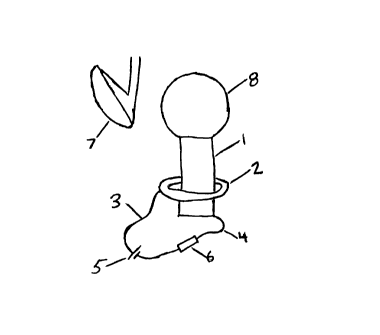Note: Descriptions are shown in the official language in which they were submitted.
CA 02230400 1998-04-30
Sgecificatiorls
The invention relates to a sensor for detecting deflection in a variety of
applications including deflection caused by striking of a ball off the
sensor's shaft in a
machine for automatically serving golf balls to a practicing golfer.
It is common in golf ball auto-teeing machines to sense the presence or
absence of
the ball by weight or light sensors. These are expensive and unreliable due to
the high
impact involved and dirt and moisture problems in this application.
This invention describes a very affordable and durable solution to sensing the
striking of a ball on a tee. In addition, this invention's sensor apparatus
can serve multiple
other applications including off level sensing, acceleration or vibration
sensing, and
passing object sensing.
In drawings which illustrate the embodiments of the invention, Figure 1 shows
the
general design of the sensor. Figure 2 shows the sensor as it applies to ball
serving
machine applications. Figure 3 shows the sensor modified for ofd level or
acceleration
sensing. Figures 4, 5, and 6 show the sensor as applied to the tasks of off
level sensing,
acceleration sensing, and passing object sensing respectively.
In Figure 1, a durable flexible shaft 1 is mounted through but not touching a
conductive ring 2. The shaft 1 is itself conductive or fitted with conductive
elements such
that when the. shaft 1 is deflected and makes contact with the ring 2, an
electric circuit
involving the shaft l and the ring 2 is momentarily completed. In this
drawing, the line
marked '3' represents a wire connected to the ring 2, and the line marked '4'
represents a
CA 02230400 1998-04-30
wire connected to the conductive elements of the shaft 1. 5 represents a power
source and
6 represents a relay or appliance activated by the momentary completion of the
circuit.
Figure 2a shows this same sensor as it would operate in a golf ball serving
machine. Figure 2b shows the same immediately after the ball 8 is struck off
the tee shaft 1
by the golf club 7. Note that the sensor shaft is deflected, closing the
sensor circuit.
In figure 3, the shaft 1 of the sensor is weighted; here this is shown by the
fixed
weight 9 fixed to the end of the sensor shaft 1. This modification allows the
sensor to
operate as an off level or acceleration sensor.
Figure 4 shows the sensor activated by the pull of gravity on the sensor shaft
weight 9, causing deflection of the sensor shaft 1 when the unit is adequately
tilted or "off
level".
Similarly figure 5 shows the sensor activated by acceleration in the direction
of the
arrow marked 10 and representing the direction of acceleration of the unit.
Note that the
sensitivity of the sensor can be modified by varying the flexibility of the
shaft 1, the mass
of the weight 9, and the clearance between the sensor shaft 1 and the
conductive ring 2.
When modified for high sensitivity, the sensor can detect fine vibration.
Figure 6 shows the sensor operating as a passing object sensor. A passing
object
11 moving in the direction of the arrow marked 12 causes deflection of the
sensor shaft 1
thus activating the sensor.
